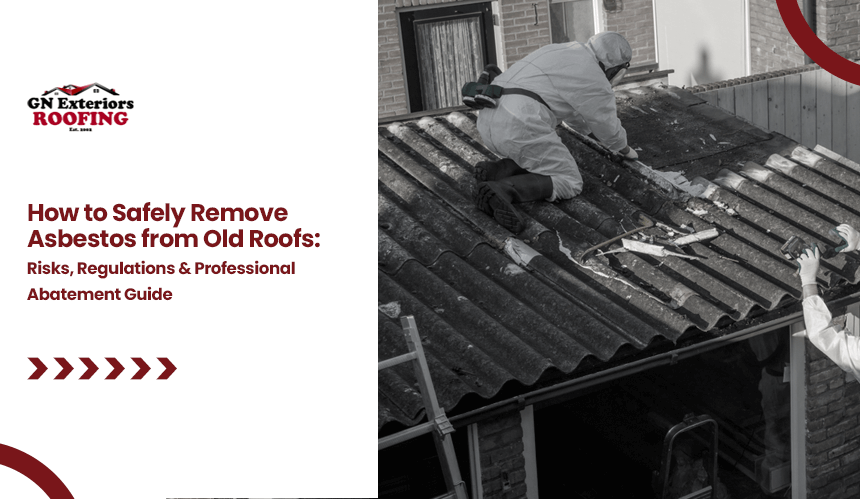
Asbestos was once a popular material used in roofing, primarily due to its durability, fire-resistant properties, and cost-effectiveness. For many decades, it was common in homes and commercial buildings, especially in roofing shingles, tiles, and insulation.
If you own an older property or are dealing with roofing repairs, understanding the presence of asbestos and the potential risks it poses is essential. This guide will walk you through how to safely handle asbestos removal, the associated regulations, and when to call in a professional.
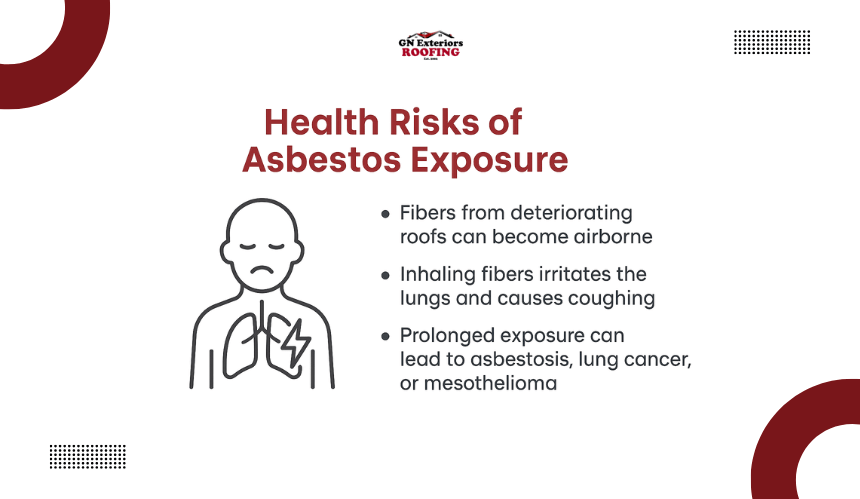
Asbestos exposure can pose severe health risks, especially when it comes to roofing materials. When intact, asbestos itself isn’t dangerous, but as roofs age and deteriorate, the risk of asbestos fibers being released into the air increases significantly. Once inhaled, these fibers can cause life-threatening illnesses.
Inhaling asbestos fibers can lead to both short-term and long-term health problems. Initially, exposure may cause irritation in the lungs, leading to symptoms like coughing, shortness of breath, and chest pain. However, the real danger lies in chronic exposure, which can cause serious conditions over time, such as:
When roofing materials containing asbestos begin to break down, due to weathering, aging, or physical damage, they release tiny asbestos fibers into the air. These fibers can be inhaled easily and, because they are microscopic, can remain suspended in the air for long periods, making them difficult to avoid.
It’s important to remember that once asbestos is disturbed, the danger isn’t always immediately visible. The fibers that pose the greatest threat are too small to see with the naked eye, yet they can stay in the air for hours or even days, increasing the chances of inhalation.
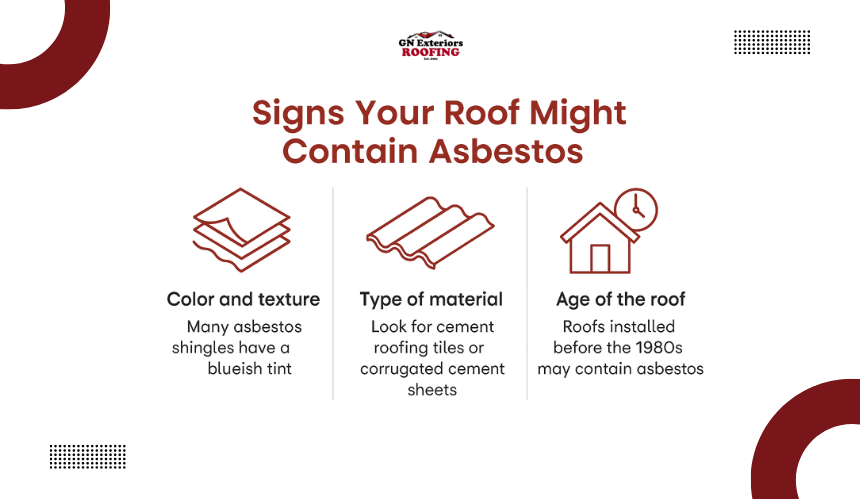
Identifying asbestos in roofing materials can be challenging, especially if you aren’t familiar with the signs. Since asbestos was commonly used in homes built before the 1980s, if your roof is older, there’s a higher chance it may contain asbestos. However, just because a roof is old doesn’t necessarily mean it’s made with asbestos.
Asbestos-containing roofing materials were often used in products like shingles, tiles, and cement-based roofing systems. Some key characteristics to look for include:
While intact asbestos materials are generally safe, any damage to the roof, such as cracks, leaks, or wear and tear, can disturb the asbestos fibers, making them airborne. Look for the following indicators that may signal asbestos exposure:
If you notice any of these signs, it’s essential to avoid disturbing the area and consider having a professional conduct a thorough inspection and testing to confirm if asbestos is present.
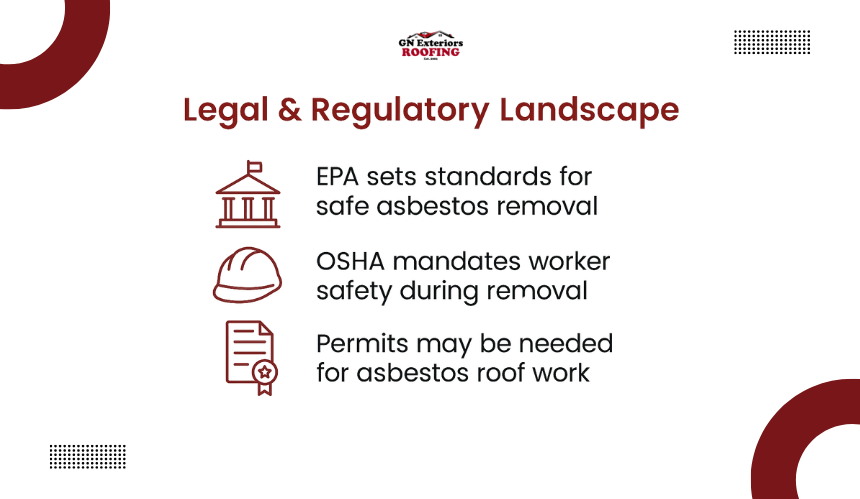
When it comes to asbestos removal, strict legal procedures must be followed to ensure safety and compliance with regulations. Asbestos is classified as a hazardous material, and mishandling it can result in serious health risks, environmental contamination, and legal consequences.
The Environmental Protection Agency (EPA) and the Occupational Safety and Health Administration (OSHA) are the primary agencies responsible for setting and enforcing asbestos removal guidelines.
Depending on the jurisdiction, homeowners or contractors may need to secure specific permits before removing asbestos from an old roof. These permits ensure that the removal process adheres to legal standards for health and safety. Local regulations may vary, so it’s essential to check with your city or county office to understand the exact requirements.
Failure to obtain the necessary permits can result in fines, delays, and even legal action. It’s important to understand your responsibilities as a homeowner and ensure that all legal requirements are met before beginning any asbestos removal.
To stay compliant, it’s vital to follow all required protocols for safe handling, removal, and disposal. This is where experienced professional roofing contractors come into play, as they understand and manage all aspects of the legal framework surrounding asbestos removal, from permits to proper disposal.
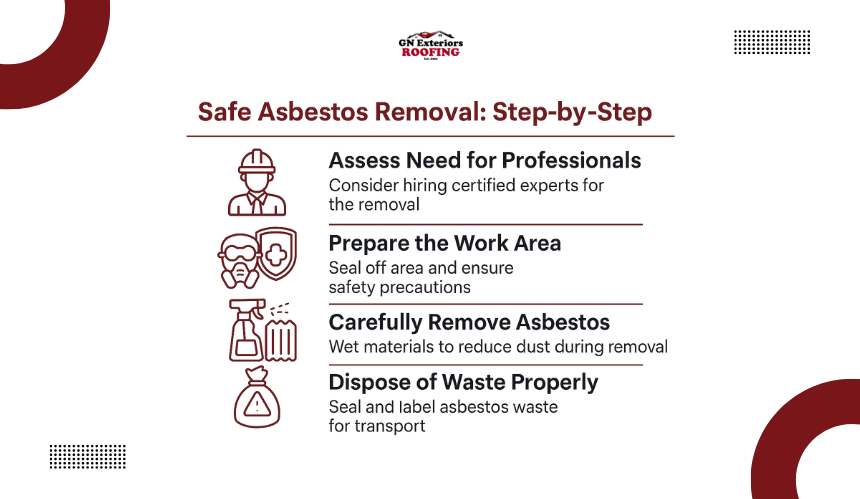
Removing asbestos from old roofs is a delicate process that requires careful planning, the right tools, and adherence to safety protocols.
Due to the dangers involved, it’s crucial to approach asbestos removal with caution. Here’s a step-by-step guide on how to safely remove asbestos from your roof while minimizing the risks.
Before you start the removal process, the first thing to consider is whether the job should be done by a professional. Asbestos removal is a hazardous process that requires specialized knowledge and equipment. If the roof is in poor condition or the asbestos material is heavily damaged, it’s best to hire certified professionals who can handle the removal safely.
Once you’ve decided to proceed with the removal, preparation is key. Here’s how to prepare the area:
The actual removal of asbestos from the roof should be done carefully to minimize fiber release. Key steps in the removal process include:
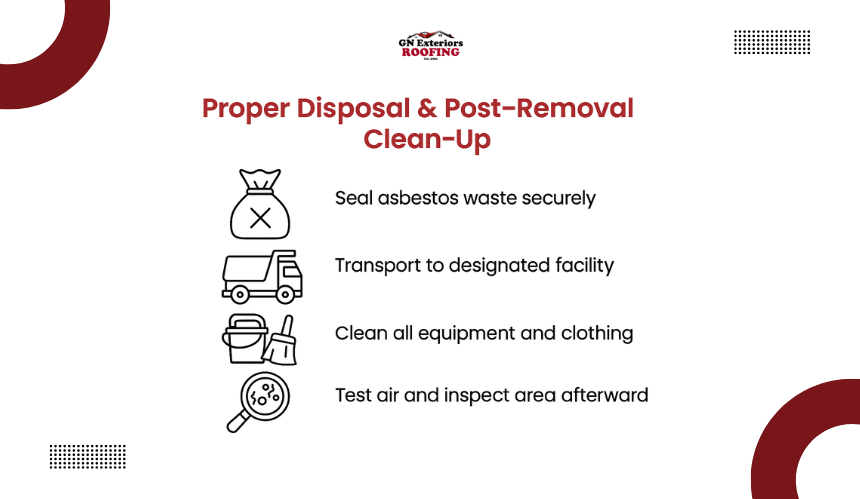
Proper disposal of asbestos roofing materials is crucial for maintaining safety and legal compliance. Asbestos waste must be carefully packaged in sealed, leak-proof containers, clearly labeled with warning signs indicating that the materials contain asbestos.
These materials should be transported to a certified asbestos disposal facility. Disposing of asbestos improperly can result in serious environmental hazards and legal consequences, so it’s essential to follow all local regulations regarding asbestos waste disposal.
After the asbestos removal is complete, thorough cleaning is necessary to ensure that all asbestos fibers have been removed from the area. Here are the key steps:
Following these steps carefully ensures that asbestos is removed safely and legally. While DIY removal might seem tempting, the best course of action is to consult with professional roofing contractors who specialize in asbestos abatement.
If you suspect your roof may contain asbestos or need professional help with asbestos removal, GN Exteriors is here to ensure your safety and peace of mind. Our certified team specializes in safe, efficient asbestos abatement and roof renovations.
If you suspect asbestos is in your roofing material, do not begin any renovation work until the asbestos has been professionally tested and removed if necessary. Disturbing asbestos can release harmful fibers into the air, so it’s crucial to handle it safely before any other work is done. Hiring certified professionals for both testing and removal ensures the renovation can proceed without any health risks.
The time required for asbestos roof removal depends on various factors, including the size of the roof, the condition of the materials, and the complexity of the job. On average, it can take anywhere from a few days to a week to complete the entire process, including removal, disposal, and air quality testing. Professional contractors can provide a more accurate timeline after assessing the specifics of your roof.
In some cases, encapsulation may be an alternative to full removal. This involves sealing asbestos-containing materials with a protective coating to prevent fibers from being released. However, encapsulation is a temporary solution and may not be appropriate for all situations, especially if the asbestos is deteriorating. Consult with a professional to determine the best course of action based on your roof’s condition.
Yes, new technologies in asbestos removal are emerging to improve safety and efficiency. Air filtration systems with advanced HEPA filtration, robotic removal technologies, and more precise containment methods are being implemented to minimize exposure. These innovations help improve the safety of the process and reduce human error, making it more effective and less intrusive.
If the cost of asbestos removal is a concern, some states or local governments offer financial assistance or programs to help cover the expenses of asbestos abatement, especially for low-income households or older homes. It’s also advisable to get multiple quotes from licensed contractors to find the most affordable, safe option for your situation.
Extreme weather conditions, particularly moisture, heat, and humidity, can cause asbestos-containing roofing materials to deteriorate more quickly. Over time, rain, snow, and temperature fluctuations may weaken the roof, increasing the risk of asbestos fibers being released into the air. Regular inspections are necessary to detect any signs of damage or wear.
You can sell a house with asbestos in the roof, but full disclosure is legally required in most areas. Many potential buyers may be hesitant about purchasing a property with asbestos, and they might request an asbestos inspection or abatement before proceeding. In some cases, it may be in your best interest to address the issue before listing the property.
Yes, asbestos removal can be done year-round, including in the winter months. However, adverse weather conditions like freezing temperatures or heavy snow may cause delays in the process. Contractors may need to take extra precautions to keep the work area safe and ensure the removal process is completed without complications.